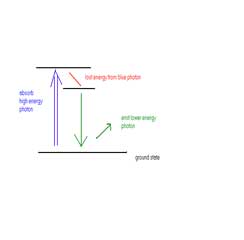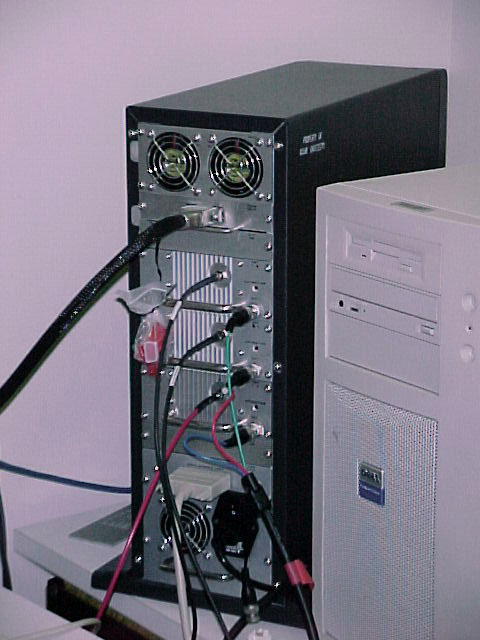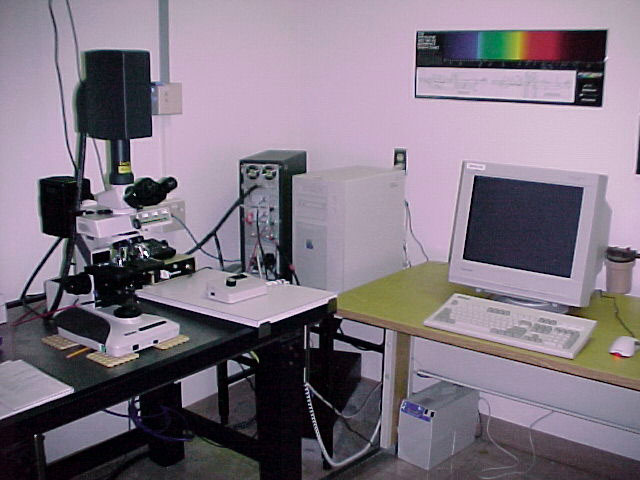
|
What is a Confocal Microscope?
|
|
Confocal microscopy has several advantages over traditional light microscopy. The laser-scanning confocal microscope slices incredibly clean, thin optical sections out of thick specimens by either reflection or fluorescence. It can view specimens in planes running parallel to the line of sight; it images deep into light scattering samples, it produces impressive 3-dimensional views at very high resolution.
|
 |
|
This Laser Scanning Confocal Microscope is located at Miami University in Oxford, Ohio.
|
|
The confocal microscope was invented by Marvin Minsky. His original idea was to move the sample in order to scan it, rather than to use scanning mirrors. With the invention of the laser, confocal microscopes became practical.
|
|
If you shine light on some molecules, you may see light of a different color emitted from that molecules. This is known as fluorescence. The molecules absorbs high energy light. This increases the energy of the molecules, known as excited molecules. Some of the energy from the blue photon is lost internally. The molecules then emits a photon with less energy. A common dye called Fluorescein acts in exact same way, emitting green light when hit with blue excitation light. The color of light emitted is material dependent, and likewise the excitation light wavelength depends on the material. Using fluorescence can result in high illumination for a more detailed image.
|
 |
|
The advantage of fluorescence for microscopy is that you can often attach fluorescent dye molecules to specific parts of your sample, so that only those parts are the ones seen in the microscope. You can also use more than one type of dye. By changing the excitation light, you can cause one type of dye to fluoresce, and then another, to distinguish two different parts of your sample. |
|
How does Confocal Microscope Work?
|
|
There are some lenses inside the microscope, these lenses focus light from the focal point of one lens to another point. The light from another point in the sample, which is not at the focal point of the lens, but is imaged by the lenses of the microscope. The image of one focal point is not at the same location as the image of the another focal point. Points don't need to be at the focal point of the lens in order for the lens to form an image. So, we want to just look at the one point, that is, the point directly at the focus of the lens. If we put a screen with a pinhole at the other side of the lens system, at the image of the one focal point, then all of the light will pass through this pinhole. However, most of the light from the second focal point is still out of focus at this screen, and gets blocked by the pinhole. |
|
Normally, the sample is completely illuminated by the excited light, so all of the sample is fluorescing at the same time. Of course, the highest intensity of the excited light is at the focal point of the lens, but other parts of the sample do get some of this light and they do fluoresce. This contributes to a background haze in the resulting image. Adding a pinhole combination solves this problem. Because the focal point of the objective lens of the microscope forms an image where the pinhole is, these two points are known as conjugate points. The pinhole is conjugate to the focal point of the lens, making it a confocal pinhole. |
|
CLICK IMAGE FOR MORE DETAIL The confocal microscope simply has two pinholes through which the light must pass before it enters the eye. A laser is used to provide the excited light, or light with very high intensities. Light from the laser must pass through the first pinhole A before it reaches the condenser lens, which focuses it onto the specimen. Light from the specimen passes through the objective lens and is focused through the second pinhole B. Any light coming from the specimen that is not in focus will not pass through the second pinhole B and will not be detected. |
|
The advantage of the confocal microscope over the normal light microscope is the subtraction of out of focus light so a much clearer image is produced. Any part of a specimen that is blurry cannot be seen with the confocal so the image has no depth. |
|
There never is a complete image of the sample, at any given instant, only one point of the sample is observed. The detector is attached to a computer which builds up the image, one pixel at a time. In practice, this can be done perhaps 3 times a second, for a 512x512 pixel image. The limitation is in the scanning mirrors. This uses a high-frequency sound wave in a special crystal to create a diffraction grating, which deflects the laser light. By varying the frequency of the sound wave, the computer changes the angle of the diffracted light, helping scan the sample quickly, allowing 512x480 pixel images 30 times per second. If you want to look at a smaller field of view, confocal microscopes can go even faster, up to 480 frames per second, although 240 frames per second is a good practical limit.
|

This digital computer (digitizer) transfers the image from the microscope to a computer screen for viewing.
This is an image of a nematode taken at Miami University in Oxford, Ohio |
|
What is the advantage of using a confocal microscope?
|
|
By having a confocal pinhole, the microscope is really efficient at rejecting out of focus light. The practical effect of this is that your image comes from a thin section of your sample, this provides you with a small depth of field. By scanning many thin sections through your sample, you can build up a very clean three-dimensional image of the sample. |

To explain how a confocal microscope displays a depth of field, look at the imaginary cell with a imaginary organelle. |
|
The confocal microscope is said to have a very small depth of field. The confocal microscope is used to take a series of pictures as it focuses at different depths through the cell. Only the parts of the imaginary cell organelle pictured above are in the plane of focus that is detected at any one time. The series of pictures are stored on computer then they can be converted into a very sharp three dimensional image -by the computer software.
|
|
Image Links
|
 |